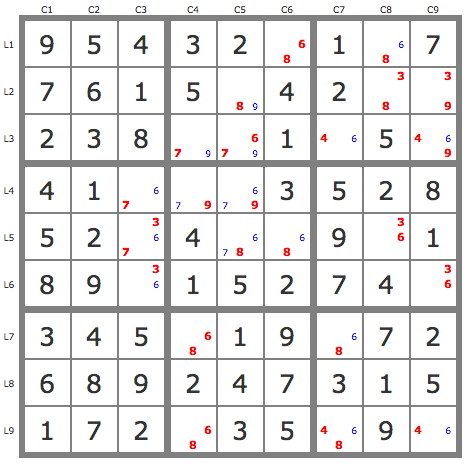Let me start with, that i agree with Serg, that we should talk about the more general "RW's rule", which has exactly the same proof. Why should we always restrict us to a special case ? Because UR1.1's are harder to find ??
Leren wrote:Here is a better example : this time I removed the 9 from r9c8 : .5........6.5.42....8.71...4....36.8.........89.1..7..3...........2.7.1..72.3.... and there were the following 175 solutions:
...
As far as I can see, the only other value that r2c9 can have is 3.
No, it is r3c2, which has 3 in all solutions, not r2c9. 7 and 9 can be in any cells of the rectangle r12c19, so you cannot use it without uniquness assumption.
Mauriès Robert wrote:
- Code: Select all
a b
b ac
...
Indeed, there are puzzles with multiple solutions where c is common to all the solutions of the puzzle (see the example proposed by Denis Berthier) and puzzles with multiple solutions where at least one solution does not contain c (I can propose some).
If none of them is a given, c must be part of a solution. This has been proved now again and again. But feel free to give a counter-example.
denis_berthier wrote:ghfick wrote:I tried Philip Beeby's solver. Using only steps up to 'Advanced Set' but not 'Deadly' takes one to :
[...]
so r2c9 is 3.
So, we reach the same conclusion: it doesn't result from some UR1.1
The conclusion is, that it can be derived without UR1.1. That is trivial.
denis_berthier wrote:... what's the (other) extra-logical assumption in RedEd's proof? My two cents is uniqueness, because in case of non-uniqueness, it seems that the a/b/b/ac pattern cannot be found in any resolution path if there is no given in the a/b/c part. All the examples examined until now support this conclusion.
The main reason, that we have no examples is, that no one searched for them. Why should one ? Just to give you an example for something, which is proved anyway ? Nobody here is interested in multi-solution puzzles. This is not worth the time. What is true is, that good examples are very rare and therefore hard to find.
Leren wrote:So you can picture Red Ed's move as :
- Code: Select all
12 12
12 12+3
ie I don't see any fundamental difference between UR1.1 and good old UR 1. Takes a bit of getting used to but it works - one of the best sections in Hodoku IMHO.
No. Only if you can eliminate one of the 1's or 2's (without uniqueness methods), you can place the 3 as a non uniqueness move.
Using uniqueness the UR1.1 is a also a simple hidden unique rectangle.


